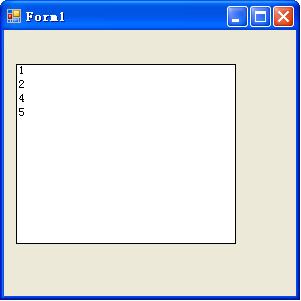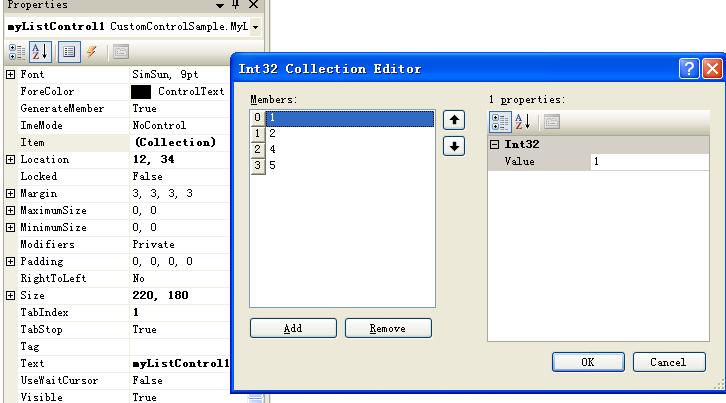C#控件属性串行化是如何实现的呢?我们在这里向你介绍C# WinForm控件开发中的应用,那么具体的操作是什么呢?是用什么属性来实现呢?那么让我们来看看具体的实现。
C#控件属性串行化的相关概念介绍:
◆DesignerSerializationVisibilityAttribute的功能是指示一个属性是否串行化和如何串行化,它的值是一个枚举,一共有三种类型Content,Hidden,Visible。Content指示代码生成器为对象包含的内容生成代码,而不是为对象本身,Hidden指示代码生成器不为对象生成代码,visible指示代码生成器为对象生成代码。假如你的控件有一个集合属性,又想在设计时自动将集合属性的内容生成代码,那么就使用这个Attribute,并将值设为DesignerSerializationVisibility.Content。
◆TypeConverterAttribute的作用就更大一些,也稍微复杂一些。TypeConverterAttribute主要的目的是为属性指定一个类型转换器,这个转化器可以将属性的值转换城其它的类型。.NET框架已经为大部分常用的类型都提供了类型转换器,比如Color就有ColorConverter,枚举类型就有EnumConverter,等等,所以一般情况下你没有必要写类型转换器,如果你的属性的特殊的类型或者自定义的类型那么就必须要写了。类型转换器都是从System.ComponentModel.TypeConverter派生出来的,你需要重写其中的一些方法来达到转换的目的,在我们开发的过程中,其实只关心属性的值如何转换成字符串(因为属性的值需要在属性浏览器里显示出来,属性浏览器里显示的都是字符串)和源代码(需要自动为属性的值生成源代码以实现持久化),当然反过来,也要将字符串和源代码转换成属性的值。另外使用TypeConverter也可以实现子属性,让属性的子属性也显示在属性浏览器里,并且可以折叠。
C#控件属性串行化实例:
- using System;
- using System.Collections.Generic;
- using System.Text;
- using System.Windows.Forms;
- using System.Drawing;
- using System.ComponentModel;
- using System.Collections;
- namespace CustomControlSample
- {
- public class MyListControl:System.Windows.Forms.Control
- {
- private List
_list = new List(); - public MyListControl()
- {
- }
- [Browsable(true)]
- public List
Item - {
- get
- {
- return _list;
- }
- set
- {
- _list = value;
- }
- }
- protected override void OnPaint(PaintEventArgs e)
- {
- base.OnPaint(e);
- Graphics g = e.Graphics;
- //绘制控件的边框
- g.DrawRectangle(Pens.Black,new Rectangle(Point.Empty,new Size(Size.Width-1,Size.Height-1)));
- for (Int32 i = 0; i < _list.Count; i++)
- {
- g.DrawString(_list[i].ToString(), Font, Brushes.Black,1, i * FontHeight);
- }
- }
- }
- }
我创建了一个简单的List控件,将用户输入的数据显示在控件中,效果图如下:

在这个控件中,我声明了一个集合属性Item供用户输入要显示的整型数值。我们按照WinForm控件制作教程(二)中的方法将控件加到ToolBox里,然后拖到Form设计器中,然后选中控件,在属性浏览中查看控件的属性,属性中有一个Item的属性,属性右边的值显示为Collection,当你点击这个值的时候,值的右边出现一个小按钮,点击这个小按钮,就会出现弹出一个Collection Editor窗口,你可以在在这个编辑器里添加你想显示的整型值,如图:

添加完以后,关闭Collection Editor。现在我们看看Form设计器为我们生成了什么代码。对于用户在Form设计器中设计的内容,设计器的代码生成器会将代码生成到窗口类的InitializeComponent()方法中,对于vs2005来说,这个方法位于***.Designer.cs文件中,在我当前的工程中位于Form1.Designer.cs文件中。在solution浏览器中双击打开这个文件,看看Form设计器为我们生成了什么代码:
- //
- // myListControl1
- //
- this.myListControl1.BackColor =
- System.Drawing.SystemColors.ActiveCaptionText;
- this.myListControl1.Item = ((
- System.Collections.Generic.List<int>)
- (resources.GetObject("myListControl1.Item")));
- this.myListControl1.Location = new System.Drawing.Point(12, 34);
- this.myListControl1.Name = "myListControl1";
- this.myListControl1.Size = new System.Drawing.Size(220, 180);
- this.myListControl1.TabIndex = 1;
- this.myListControl1.Text = "myListControl1";
设计器将Item的内容串行化到了资源文件里。现在我们修改控件的代码,让设计器将Item的内容串行化到源代码里。我们为Item属性添加DesignerSerializationVisibilityAttribute,代码片断如下:
- [Browsable(true)]
- [DesignerSerializationVisibilityAttribute(
- DesignerSerializationVisibility.Content)]
- public List
Item - {
- get
- {
- return _list;
- }
- set
- {
- _list = value;
- }
- }
编辑完以后,Build控件工程,回到测试工程里,将Item属性里的值,删掉重新添加,添加完以后,我们再来看看设计器生成的代码:
- //
- // myListControl1
- //
- this.myListControl1.BackColor = System.Drawing.SystemColors.ActiveCaptionText;
- this.myListControl1.Item.Add(1);
- this.myListControl1.Item.Add(2);
- this.myListControl1.Item.Add(3);
- this.myListControl1.Item.Add(6);
- this.myListControl1.Item.Add(8);
- this.myListControl1.Item.Add(9);
- this.myListControl1.Location = new System.Drawing.Point(12, 34);
- this.myListControl1.Name = "myListControl1";
- this.myListControl1.Size = new System.Drawing.Size(220, 180);
- this.myListControl1.TabIndex = 1;
- this.myListControl1.Text = "myListControl1";
现在设计器将Item的内容串行化到源代码里了。
C#控件属性串行化的具体实现就向你介绍到这里,希望随你了解和C#控件属性串行化有所帮助。
【编辑推荐】























